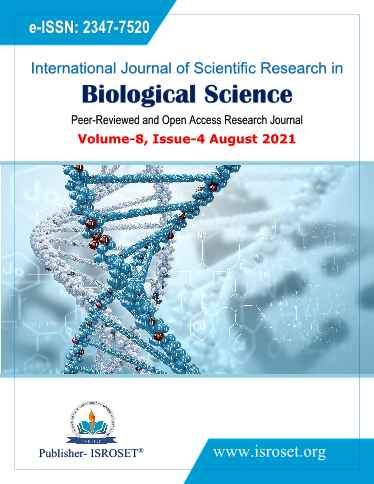Biodegradation of Crude oil Contaminated Soils Using Fungal Species
Keywords:
Crude oil, contaminated soil, fungi, Kaduna refineryAbstract
Crude oil contamination of soil in the environment has increase due to increase in vandalizations and corrosions of pipelines particularly where refineries and deports are located as well as accidental discharge during transportation and increased in demand on hydrocarbon products, which lead to the need to clean up spilled petroleum using biodegradation method. This research aimed at isolating fungal species from crude oil contaminated soil and their ability to degrade volatile organic compounds within petrochemical company (KRPC) in Kaduna State, Nigeria. The fungi were determined using poured plate method. Aspergillus flavus (4[20%]), Aspergillus fumigatus (6[30%]), Aspergillus niger (6[30%]), Rhizopus oryzae (2[10%]) and Microsporum audouinii (2[10%]) were isolated and identified with different frequencies. The degradation level of fungi species analyzed, using gas chromatography, showed Rhizopus oryzae and Aspergillus niger were the highest degraders that have degraded all the natural products found in crude oil and Aspergillus flavus was the least degrader. The use of these fungal species to clean impure crude oil soils could be employed. Therefore, these species more especially Aspergillus niger and Rhizopus oryzea might be produced in large quantity and employed in bioremediation process.
References
F. Challain, A. Flecheb, E. Burga, Y. Phantavonga, A. Saliot, J. Oudot, “Identification and Biodegradation Potential of Tropical Aerobic Hydrocarbon-Degrading Microorganisms”. Resident Microbes. 155 (7):587-595, 2004.
R.S. Thavasi, T. Jayalakshmi, M. Balasubramanian, I.M. Banat, ‘Biodegradation of Crude Oil by Nitrogen Fixing Marine Bacteria Azotobacter Chrococcum”. Journal. Microbiology, 1:pp. 401-408, 2006.
C.D. Batelle, “Mushrooms: Higher Macrofungi to clean up the environment. Batelle Environmental Issues, Fall. 2000
M. Throne-Holst, A. Wentzel, T.E. Ellingsen, H.K. Kotlar, S.B. Zotchev, “Identification of novel genes involved in long-chain nalkane degradation by Acinetobacter sp. Strain DSM 17874”, Applied Environmental Microbiology, vol. 73, no.10, Pp. 3327–3332, 2007.
S. Farag, N.A. Soliman, “Biodegradation of Crude Petroleum Oil and Environmental Pollutants by Candida tropicalis Strain”, Braz. Arch. Biolology Technology, vol. 54, no.4, Pp. 821-830, 2011.
H. Al-Nasrawi, “Biodegradation of Crude Oil by Fungi Isolated from Gulf of Mexico”. Journal of Bioremediation Biodegradition, vol. 3, Pp. 1-6, 2012.
I.F.H. AI-Jawhari, “Ability of Some Soil Fungi in Biodegradation of Petroleum Hydrocarbon”. Journal of Applied Environmental Microbiology, vol. 2, no. 2, Pp. 46-52, 2014.
A.A., Burghal, M.J.A., Najwa W. Abu-Mejdad, H. Al-Tamimi, “Mycodegradation of Crude Oil by Fungal Species Isolated from Petroleum Contaminated Soil”. International Journal of Innovative Research in Science, Engineering and Technology, Vol. 5, Issue 2, 1517-1524, 2016.
Al-Dossary, M.A., Shaymaa A.A. and Hamid T.A. Biodegradation of Crude Oil Using Aspergillus species. Journal of Biology, Agriculture and Healthcare, Vol.9, No.4, 60-64, 2019.
E. Al-Jumaily, N. Al-wahab, “Nutritional requirement of Enterobacter cloacae for biodegradation of hydrocarbons”. Global Journal of Biological-Science Biotechnology, vol. 1, Pp. 65-70, 2012.
G.D. Gojgic-Cvijovic, J.S. Milic, T.M. Solevic, V.P. Beskoski, M.V. Ilic, L.S. Djokic, T.M. Narancic, M.M. Vrvic, “Biodegradation of petroleum sludge and petroleum polluted soil by a bacterial consortium: a laboratory study”, Biodegradation, vol. 23, Pp. 1-14, 2012.
O.F. Olukunle, T.S. Oyegoke, “Biodegradation of Crude oil by Fungi Isolated from Cow Dung contaminated soils”. Nigeria Journal of Biotechnology. Vol. 31; Pp. 46 –5, 2016.
A.A. Ameh, A.H. Kawo, “Enumeration, isolation and identification of bacteria and fungi from soil contaminated with petroleum products using layer droppings as an amendment”. Bayaro. Journal of pure and applied science, 10(1) 219-225, 2017.
A.K. Onifade, F.A. Abubakar “Characterization of Hydrocarbon-Degrading Microorganisms Isolated from Crude Oil Contaminated Soil and Remediation of the Soil by Enhanced Natural Attenuation”. Research Journal of Microbiology, 2: 149-155, 2007
M.D. Asemoloye, T. Solveig, D. Chiara, W. Xiao, X. Shihan, A.M. Mario, G. Wenyuan, G.J. Segun, P. Lorenzo, “Hydrocarbon Degradation and Enzyme Activities of Aspergillus oryzae and Mucor irregularis Isolated from Nigerian Crude Oil-Polluted Sites”. Microorganisms, 8, 1912; doi:10.3390/microorganisms8121912, 2020.
S.K. Padhi, M. Alok kumar, P. Lopa, T. Srikant, B. Bijyalaxmi, M. Jasmin, “Isolation of Microorganism from Natural Source for Bioremediation of Oil-spill”. Bulletin of Environment, Pharmacology and Life Sciences, Volume (6); Pp. 05-09, 2012.
A.B. Al-Hawash, J.A. Alkooranee, A.H. Abbood, J. Zhang, J. Sun, X. Zhang, F. Ma, “Isolation and characterization of two crude oil-degrading fungi strains from Rumaila oil field, Iraq”. Biotechnology Reports, 17 Pp. 104 – 109, 2017.
M. Cheesebrough, “Medical Laboratory Manual Tropical Health Technology, low priced edition. Doddington, Cambrigdeshire, England. Pp. 20-35, 2000.
Clemente, A.R., Anazawa, T.A. and Durrant, L.R. Biodegradation of polycyclic aromatic hydrocarbons by soil fungi. Braz. Journal Microbiology, 32: Pp. 1-9, 2001.
K.C. Agu, E.B. Edet, A.N. Sunday, A.C.G. Chidi, C.E. Uche, M.O. Uchenna, A.O. Chinedu, A.O. Chinedu, “Isolation and Characterization of Microorganisms from Oil Pulluted Soil in Kwata, Awkka South, Nigeria”. American Journal of Current Microbiology, 3:46-59, 2014.
P.O. Okerentugba, O.U. Ezeronye, “Petroleum degrading potentials single and Microbial cultures isolated from rivers and refinery effluent in Nigeria”. African Journal of Biotechnology, 9, 288-292, 2003.
W.K. Catherine, “Isolation and Characterization of Hydrocarbon Biodegrading Fungi from oil contaminated Soils in thinka Kenya. A Thesis Submitted in Partial Fulfillment for the degree of Master of Science in Mycology in the Jomo Kenyatta University of Agriculture and Technology, Kenya. 2015.
O. Dahan, I. Katz, L. Avishai, Z. Ronen, “Transport and degradation of perchlorate in deep vadose zone: implications from direct observations during bioremediation treatment”. Hydrology Earth System Sciences, 21:4011– 4020, 2017.
Downloads
Published
How to Cite
Issue
Section
License

This work is licensed under a Creative Commons Attribution 4.0 International License.
Authors contributing to this journal agree to publish their articles under the Creative Commons Attribution 4.0 International License, allowing third parties to share their work (copy, distribute, transmit) and to adapt it, under the condition that the authors are given credit and that in the event of reuse or distribution, the terms of this license are made clear.







